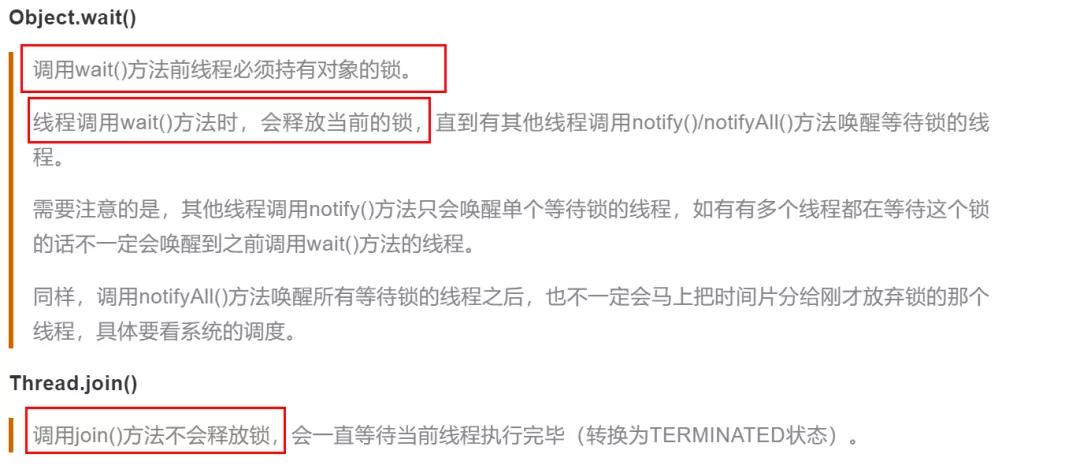本文转载自微信公众号「编了个程」,作者Yasin x 。转载本文请联系编了个程公众号。
Y说
今天没什么要说的。我个人很喜欢拍天空的照片,放一张前段时间晚上拍的照片吧。
join方法释放锁吗?
前段时间,有一个读者私信我,问了这么一个问题:Thread实例的join方法内部是调用的wait方法,而wait方法是会释放锁的,为什么网上很多文章(包括我们之前写的开源书《深入浅出Java多线程》)会说join方法不释放锁?
释放thread对象锁
我们先用书中的一个例子说起:
- public class Join {
- static class ThreadA implements Runnable {
- @Override
- public void run() {
- try {
- System.out.println("我是子线程,我先睡一秒");
- Thread.sleep(1000);
- System.out.println("我是子线程,我睡完了一秒");
- } catch (InterruptedException e) {
- e.printStackTrace();
- }
- }
- }
- public static void main(String[] args) throws InterruptedException {
- Thread thread = new Thread(new ThreadA());
- thread.start();
- thread.join();
- System.out.println("如果不加join方法,我会先被打出来,加了就不一样了");
- }
- }
在这个例子中,我们在main方法中调用了thread.join(),打印出来的效果就是:
- 我是子线程,我先睡一秒
- 我是子线程,我睡完了一秒
- 如果不加join方法,我会先被打出来,加了就不一样了
这个例子想要表达的意图很简单,就是通过thread实例的join方法,达到main线程等待thread线程执行完后再继续执行的效果。
那join方法底层是如何实现这个功能的呢?究竟会不会释放锁呢?我们点进去看看源码。
- if (millis == 0) {
- while (isAlive()) {
- wait(0);
- }
- } else {
- while (isAlive()) {
- long delay = millis - now;
- if (delay <= 0) {
- break;
- }
- wait(delay);
- now = System.currentTimeMillis() - base;
- }
- }
可以看到,join的底层是调用的wait(long)方法。而wait方法是Object类型的实例方法,会释放当前Object的锁,且需要拿到当前Object的锁才行。
这么说可能有点绕。众所周知,「Java的锁其实本质上是对象锁」,因为我们前面调用的是thread.join(),所以这里的“锁”对象其实thread这个对象。那这里wait释放的是thread这个对象锁。
我们把上面的main方法简单改一下,用另一个线程是占住thread这个对象锁,就比较直观了:
- public static void main(String[] args) throws InterruptedException {
- Thread thread = new Thread(new ThreadA());
- thread.start();
- new Thread(() -> {
- // 把thread对象作为锁占住,这样下面的join里面的wait只有等锁释放了才能执行。
- synchronized (thread) {
- try {
- System.out.println("我占住了thread锁");
- Thread.sleep(10000);
- System.out.println("我thread锁释放了");
- } catch (InterruptedException e) {
- e.printStackTrace();
- }
- }
- }).start();
- thread.join();
- System.out.println("如果不加join方法,我会先被打出来,加了就不一样了");
- }
打印结果:
- 我是子线程,我先睡一秒
- 我占住了thread锁
- 我是子线程,我睡完了一秒
- 我thread锁释放了
- 如果不加join方法,我会先被打出来,加了就不一样了
这就印证了那句话:wait方法执行前,是需要获取当前对象的锁的。
所以回归到最开始的问题:join()方法会释放锁吗?严瑾的答案是它会释放thread实例的对象锁,但不会释放其它对象锁(包括main线程)。stackoverflow也对这个有讨论:Does Thread.join() release the lock? Or continue to hold it?。
简单来说,你说它释放了锁也对,因为它确实通过wait方法释放了thread对象锁,你说它没释放锁也对,因为从调用线程的角度来看,它并没有释放当前调用线程持有的对象锁。
当然,为了防止其它读者看到这也有这个疑惑,我直接把文中的这句话删掉了。
^image.png^
谁唤醒了?
源码看到这,我又有了一个新的疑问:join方法内部是一个while循环。wait释放了锁,那必然会有一个人来唤醒它,程序才能够继续往下走。那必然有一个地方调用了thread对象的notify方法。
我们在Thread类里面可以找到一个exit()方法,上面备注写着:This method is called by the system to give a Thread a chance to clean up before it actually exits.
这么简单的英文大家应该都能看懂吧?
里面有这么一段代码:
- if (group != null) {
- group.threadTerminated(this);
- group = null;
- }
- void threadTerminated(Thread t) {
- synchronized (this) {
- remove(t);
- if (nthreads == 0) {
- notifyAll();
- }
- if (daemon && (nthreads == 0) &&
- (nUnstartedThreads == 0) && (ngroups == 0))
- {
- destroy();
- }
- }
- }
一开始我以为是在这里唤醒的,但仔细一看,这里调用的对象是ThreadGroup的实例,而不是thread实例。所以应该不是这个地方。
经过一通google之后,我又在stackoverflow上找到了正确的答案(stackoverflow, yyds):who and when notify the thread.wait() when thread.join() is called?
答案显示,这是在JVM层面去做的事:
- static void ensure_join(JavaThread* thread) {
- // We do not need to grap the Threads_lock, since we are operating on ourself.
- Handle threadObj(thread, thread->threadObj());
- assert(threadObj.not_null(), "java thread object must exist");
- ObjectLocker lock(threadObj, thread);
- // Ignore pending exception (ThreadDeath), since we are exiting anyway
- thread->clear_pending_exception();
- // Thread is exiting. So set thread_status field in java.lang.Thread class to TERMINATED.
- java_lang_Thread::set_thread_status(threadObj(), java_lang_Thread::TERMINATED);
- // Clear the native thread instance - this makes isAlive return false and allows the join()
- // to complete once we've done the notify_all below
- java_lang_Thread::set_thread(threadObj(), NULL);
- lock.notify_all(thread);
- // Ignore pending exception (ThreadDeath), since we are exiting anyway
- thread->clear_pending_exception();
- }
可以看到除了notify_all以外,它其实做了很多扫尾的工作。包括处理异常、设置线程状态等。
如果线程没启动
再把代码改一下,如果线程没有通过start启动会怎样呢?
- Thread thread = new Thread(new ThreadA());
- // thread.start();
- thread.join();
- System.out.println("如果不加join方法,我会先被打出来,加了就不一样了");
会直接执行最后一行代码打印出来。
看join源码就知道了,在wait之前,会有一个isAlive()的判断,看当前线程是否是alive的。如果没有start,那就会直接返回false,不进入wait。
总结
join方法会释放thread对象锁,底层是wait方法,在JVM层面通过notify_all来唤醒的。


































